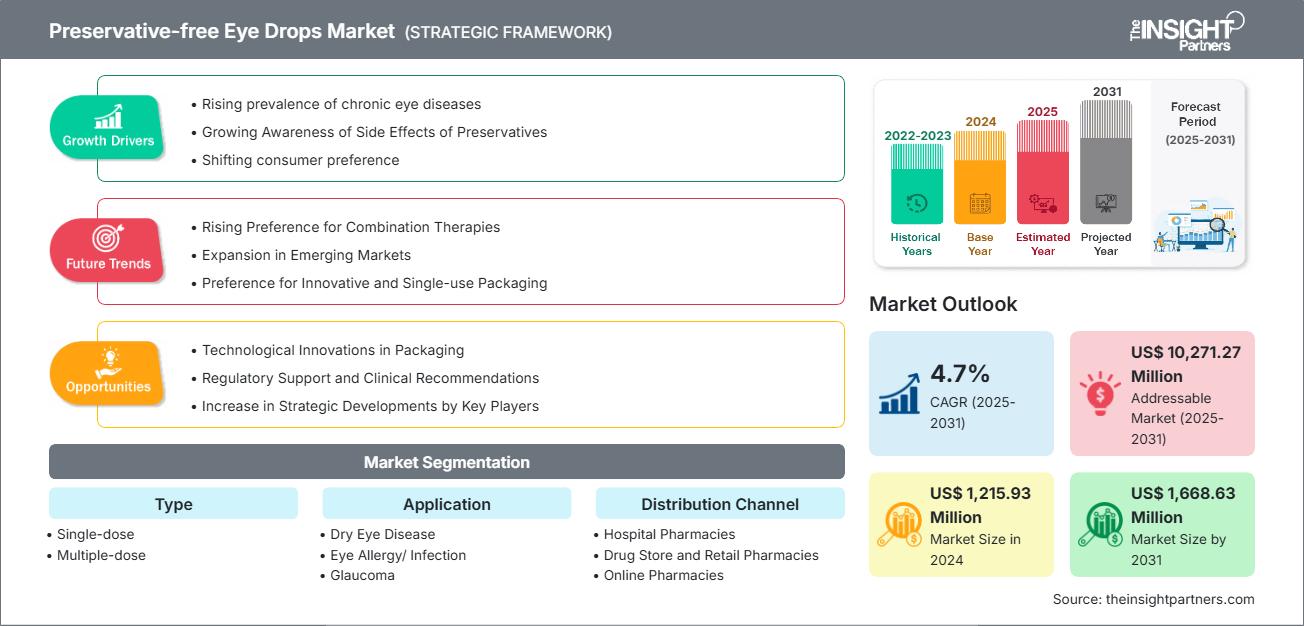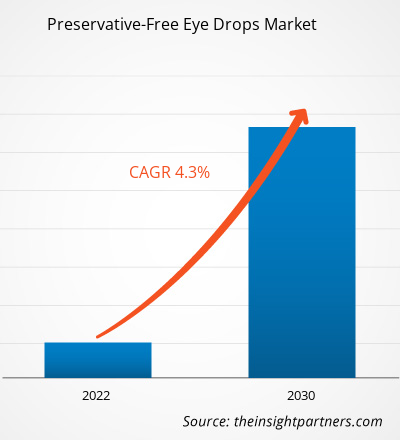防腐剤不使用の点眼薬市場は、2024年の12億1,000万米ドルから2031年には16億3,000万米ドルに達し、2025年から2031年にかけて4.7%のCAGRで成長すると予測されています。CAGR of 4.7% during 2025–2031.
防腐剤フリー点眼薬市場分析
慢性眼疾患の罹患率の増加、防腐剤の副作用に対する意識の高まり、そして消費者の嗜好の変化が市場の成長を牽引しています。パッケージングにおける技術革新は、今後数年間、防腐剤無添加点眼薬市場に大きなビジネスチャンスをもたらすでしょう。
防腐剤フリー点眼薬市場概要
アイケア市場では、防腐剤不使用の点眼薬への需要が高まっています。点眼薬に使用される防腐剤の危険性に対する認識が高まっているからです。さらに、消費者が従来の製品よりも無化学物質で肌に優しい製品を好むという考え方もまた、防腐剤不使用処方の普及に重要な役割を果たしています。
北米の防腐剤無添加点眼薬市場は、充実した医療インフラと点眼薬に含まれる防腐剤の潜在的な影響に対する認識により、世界市場の最前線に位置しています。一方、アジア太平洋地域は、医療アクセスの向上、人口の高齢化、可処分所得の増加により急速に成長しています。したがって、地域間の成長ペースは、人口動態の動向、医療の発展、そして防腐剤無添加点眼薬に対する患者の選好度に大きく左右されます。
このレポートの一部、国レベルの分析、Excelデータパックなど、あらゆるレポートを無料でカスタマイズできます。また、スタートアップや大学向けのお得なオファーや割引もご利用いただけます。
防腐剤フリー点眼薬市場:戦略的洞察

- このレポートの主要な市場動向を入手してください。この無料サンプルには、市場動向から見積もりや予測に至るまでのデータ分析が含まれます。
防腐剤フリー点眼薬市場の推進要因と機会
市場の推進要因:
- 慢性眼疾患の増加:ドライアイ症候群や緑内障といった慢性眼疾患の症例数の増加は、防腐剤を含まない点眼薬の需要が高まっている主な理由です。実際、患者は眼表面にさらなる損傷を与えない、より穏やかな長期治療を求めています。
- 防腐剤の副作用に対する認識の高まり: 防腐剤の刺激性に関する患者と医師の認識が高まった結果、防腐剤を含まない点眼薬の需要が増加しています。
- 消費者の嗜好の変化:化学物質への曝露や目の過敏症への懸念から、防腐剤不使用の製品を選ぶ消費者が増えています。消費者は、ホリスティックで患者中心のヘルスケアのトレンドに合致する、天然由来で安全、そして刺激のない製品を求めています。
市場機会:
- 包装における技術革新: 新しい技術により、機械式フィルターやエアレス システムなどの製品が殺菌され、防腐剤を含まない点眼薬が簡素化され、より安全な複数回投与オプションが実現し、市場の需要に応えます。
- 規制サポートと臨床推奨事項: 規制の強化と肯定的な臨床推奨事項により、防腐剤を含まない点眼薬が最も安全な代替品として位置付けられています。そのため、市場での採用ペースが加速し、革新的な防腐剤を含まない製剤と送達システムの承認が容易になります。
- 主要プレーヤーによる戦略的開発の増加: 製品の革新、プロセスのデジタル化、持続可能なパッケージの採用、競争力の強化は、防腐剤を含まない点眼薬ポートフォリオの市場成長を促進し、その結果としてその範囲を拡大する 4 つの戦略です。
防腐剤フリー点眼薬市場レポート:セグメンテーション分析
防腐剤フリー点眼薬市場は、その仕組み、成長の可能性、そして最新のトレンドをより明確に把握するために、様々なセグメントに分割されています。以下は、ほとんどの業界レポートで使用されている標準的なセグメント分けの手法です。
タイプ別:
- 単回投与:単回投与点眼薬は防腐剤を含まず、使いやすく汚染の心配もないため、敏感な方や頻繁に点眼する方に適しています。
- 複数回投与: 防腐剤を含まない複数回投与の点眼薬は、より長い保存期間で無菌性を維持するように設計されており、簡単に使用できます。
用途別:
- ドライアイ疾患 (DED): DED が主な原因であり、これが、優しく防腐剤を含まない潤滑点眼薬が流行するきっかけとなっています。
- 目のアレルギー/感染症: 防腐剤を含まない点眼薬は、アレルギーや感染症による敏感な目に、可能な限り純粋な緩和効果をもたらします。
- 緑内障: 時間の経過とともに、慢性緑内障の治療では、防腐剤による眼表面の損傷を最小限に抑えるために、防腐剤を含まない点眼薬が使用されることが多くなります。
- 網膜疾患: 防腐剤を含まない薬剤は、長期にわたる局所治療を必要とする網膜疾患における目の健康の基盤となります。
- その他の適応症: 手術後およびコンタクトレンズ使用者という 2 つの患者グループは、防腐剤を含まない安全な点眼薬の恩恵を受けます。
流通チャネル別:
- 病院薬局
- ドラッグストアと薬局
- オンライン薬局
地理別:
- 北米
- ヨーロッパ
- アジア太平洋
- ラテンアメリカ
- 中東・アフリカ
北米における防腐剤無添加点眼薬市場は、今後も大きな市場シェアを維持すると予想されています。ドライアイ症候群や緑内障といった慢性眼疾患の発症率上昇といった要因が、特に高齢者層において市場の成長を牽引し、市場の成長を牽引すると予想されます。
防腐剤フリー点眼薬市場の地域別分析
予測期間全体を通して防腐剤フリー点眼薬市場に影響を与える地域的な傾向と要因は、The Insight Partnersのアナリストによって徹底的に解説されています。このセクションでは、防腐剤フリー点眼薬市場のセグメントと地域についても、北米、ヨーロッパ、アジア太平洋、中東・アフリカ、中南米に分けて解説しています。
防腐剤フリー点眼薬市場レポートのスコープ
| レポート属性 | 詳細 |
|---|---|
| 2024年の市場規模 | 12億1000万米ドル |
| 2031年までの市場規模 | 16億6000万米ドル |
| 世界のCAGR(2025年~2031年) | 4.7% |
| 履歴データ | 2021-2023 |
| 予測期間 | 2025~2031年 |
| 対象セグメント | タイプ別
|
| 対象地域と国 | 北米
|
| 市場リーダーと主要企業の概要 |
|
防腐剤フリー点眼薬市場のプレーヤー密度:ビジネスダイナミクスへの影響を理解する
防腐剤フリー点眼薬市場は、消費者の嗜好の変化、技術の進歩、製品メリットへの認知度の高まりといった要因によるエンドユーザーの需要増加に牽引され、急速に成長しています。需要の高まりに伴い、企業は製品ラインナップの拡充、消費者ニーズへの対応のための革新、そして新たなトレンドの活用を進めており、これが市場の成長をさらに加速させています。

- 防腐剤フリー点眼薬市場のトップキープレーヤーの概要を入手
防腐剤フリー点眼薬の地域別市場シェア分析
アジア太平洋地域は今後数年間で最も急速に成長すると予想されています。南米、中米、中東、アフリカの新興市場も、防腐剤不使用点眼薬メーカーにとって、事業拡大のための未開拓の機会を数多く提供しています。
防腐剤無添加点眼薬市場は、規制当局の推奨や防腐剤無添加製品に関する医療ガイドラインの影響により、地域ごとに成長率が異なります。以下は、地域別の市場シェアと動向の概要です。
1. 北米
- 市場シェア: 世界市場の大きな部分を占めている
- 主な推進要因: 技術的に進歩した医療システム、防腐剤の副作用に対する意識の高まり、高齢者人口の増加が、北米における防腐剤を含まない点眼薬の需要を支えています。
- トレンド:製造業の進歩と持続可能な実践
2. ヨーロッパ
- 市場シェア: 疼痛疾患の罹患率増加により大きなシェアを獲得
- 主な推進要因: 規制当局が防腐剤不使用の点眼薬に対して強力な規制枠組みを確立している主な理由としては、慢性眼疾患の罹患率の増加と、防腐剤不使用のソリューションに対する患者の選好の増加が挙げられます。
- トレンド:市場構造に対する規制の影響
3. アジア太平洋
- 市場シェア: 毎年市場シェアが上昇している最も急成長している地域
- 主な推進要因: 医療へのアクセスの向上、高齢者人口の徐々に増加する傾向、およびアジア太平洋市場における可処分所得の着実な増加により、この地域では防腐剤を含まない点眼薬が急速に成長しています。
- トレンド:製剤と送達における革新
4. 南米と中央アメリカ
- 市場シェア: 着実な進歩を遂げながら成長を続ける市場
- 主な推進要因: 南米および中米における眼科疾患の増加と医療インフラの拡大が、これらの地域で防腐剤を含まない点眼薬が採用される主な推進要因です。
- トレンド:医薬品製造における技術開発
5. 中東およびアフリカ
- 市場シェア: 小さいながらも急速に成長
- 主な推進要因: 医療業界の設備の充実と、目のケアの重要性に対する意識の高まりが、中東およびアフリカ地域で防腐剤を含まない点眼薬の需要が高まる主な理由です。
- トレンド:治療製品の成長
防腐剤フリー点眼薬市場のプレーヤー密度:ビジネスダイナミクスへの影響を理解する
高い市場密度と競争
アルコンAG、ボシュロムコーポレーション、バイエルAGといった既存企業の存在により、競争は熾烈です。ロート製薬株式会社やウルサファーム・アルツナイミッテルGmbHといった地域密着型のニッチプロバイダーの存在も、各地域における競争環境をさらに激化させています。
この高いレベルの競争により、企業は次のようなものを提供して差別化を図ろうとしています。
- 高度な製品
- カスタマイズや持続可能なソリューションなどの付加価値サービス
- 競争力のある価格モデル
- 規制ガイドラインの遵守
機会と戦略的動き
- 企業は研究開発への投資を増やしており、それが検出技術の革新を促進しています。これにより感度と特異度も向上し、様々な地域における特定の眼の健康問題への対応が可能になります。
- メーカーは、特にインドなどの大量生産市場において、コストを削減し、サプライチェーンを強化するために現地生産に重点を置くとみられる。
調査の過程で分析した他の企業:
- エセックス・バイオテクノロジー・リミテッド
- ピラー5ファーマ株式会社
- アイビジア
- コーニアケア株式会社
- ステリコン
- アイシルク
- アプターファーマ
- ウルサファーム・アルツナイミッテルGmbH
- ロート製薬株式会社
- ヒマラヤハーバルズ
防腐剤フリー点眼薬市場ニュースと最新動向
- 参天製薬、国内初となる近視進行抑制点眼液「ライジュシアミニ点眼液0.025%」を新発売 参天製薬株式会社は、このたび、「ライジュシアミニ点眼液0.025%」(有効成分:アトロピン硫酸塩水和物、以下、本剤)を新発売しました。本剤は、薬価基準外医薬品として販売され、公的医療保険の適用外となります。
- ボシュロム社、防腐剤フリーの LUMIFY 充血軽減目薬に関する第 3 相データの公表を発表 ボシュロム社は、眼の充血を軽減するための LUMIFY 充血軽減目薬と他の LUMIFY 充血軽減目薬を比較し、防腐剤フリーの LUMIFY 充血軽減目薬の有効性と安全性を評価した第 3 相研究の結果を Ophthalmology and Therapy が公表したことを発表しました。
防腐剤フリー点眼薬市場レポートの掲載内容と成果物
「防腐剤不使用点眼薬市場規模と予測(2021~2031年)」レポートでは、以下の分野を網羅した市場の詳細な分析を提供しています。
- 防腐剤フリーの点眼薬の市場規模と予測(世界、地域、国レベル)
- 防腐剤フリー点眼薬市場の動向、および推進要因、制約、主要な機会などの市場動向
- 詳細なPEST分析とSWOT分析
- 防腐剤フリー点眼薬市場分析では、主要な市場動向、世界および地域の枠組み、主要プレーヤー、規制、最近の市場動向を網羅しています。
- 市場集中、ヒートマップ分析、主要プレーヤー、防腐剤フリー点眼薬市場の最近の動向を網羅した業界展望と競争分析
- 詳細な企業プロフィール
- 過去2年間の分析、基準年、CAGRによる予測(7年間)
- PEST分析とSWOT分析
- 市場規模価値/数量 - 世界、地域、国
- 業界と競争環境
- Excel データセット
最新レポート
関連レポート
お客様の声
購入理由
- 情報に基づいた意思決定
- 市場動向の理解
- 競合分析
- 顧客インサイト
- 市場予測
- リスク軽減
- 戦略計画
- 投資の正当性
- 新興市場の特定
- マーケティング戦略の強化
- 業務効率の向上
- 規制動向への対応






















 無料サンプルを入手 - 防腐剤フリー点眼薬市場
無料サンプルを入手 - 防腐剤フリー点眼薬市場